|
|

U. S. DEPARTMENT OF TRANSPORTATION
NATIONAL HIGHWAY TRAFFIC SAFETY ADMINISTRATION
DOT HS 808 629
Introduction
|
|
Air bags are proven, effective safety devices. From
their introduction in the late 1980's through November 1, 1997, air
bags saved about 2,620 people. The number of people saved increases
each year as air bags become more common on America's
roads.
However, the number of lives saved is not the whole story. Air
bags are particularly effective in preventing life-threatening and
debilitating head and chest injuries. A study of real-world crashes
conducted by the National Highway Traffic Safety Administration
(NHTSA) found that the combination of seat belts and air bags is 75
percent effective in preventing serious head injuries and 66 percent
effective in preventing serious chest injuries. That means 75 of
every 100 people who would have suffered a serious head injury in a
crash, and 66 out of 100 people who would have suffered chest
injuries, were spared that fate because they wore seat belts and had
air bags.
For some people, these life saving and injury-preventing benefits
come at the cost of a less severe injury caused by the air bag
itself. Most air bag injuries are minor cuts, bruises, or abrasions
and are far less serious than the skull fractures and brain injuries
that air bags prevent. However, 87 people have been killed by air
bags as of November 1, 1997. These deaths are tragic, but rare
events -- there have been about 1,800,000 air bag deployments as of
that same date.
The one fact that is common to all who died is NOT their
height, weight, sex, or age. Rather, it is the fact that they were
too close to the air bag when it started to deploy. For
some, this occurred because they were sitting too close to the air
bag. More often this occurred because they were not restrained by
seat belts or child safety seats and were thrown forward during
pre-crash braking.
The vast majority of people can avoid being too close and can
minimize the risk of serious air bag injury by making simple changes
in behavior. Shorter drivers can adjust their seating position.
Front seat adult passengers can sit a safe distance from their air
bag. Infants and children 12 and under should sit in the back seat.
And everyone can buckle up. The limited number of people who may not
be able to make these changes may benefit from having the opportunity
to turn off their air bags when necessary.
Beginning January 19, 1998, consumers can choose to have an on-off
switch installed for the air bags in their vehicle if they are, or a
user of their vehicle is, in a risk group listed below. The
following information provides the facts you need about air bags so
you can make the appropriate decision for you and anyone else who is
in a risk group.
|
|
What is an on-off
switch?
An on-off switch allows an air bag to be turned on and off. The
on-off switch can be installed for the driver, passenger, or both.
To limit misuse, a key must be used to operate the on-off switch.
When the air bag is turned off, a light comes on. There is a message
on or near the light saying "DRIVER AIR BAG OFF" or "PASSENGER AIR
BAG OFF." The air bag will remain off until the key is used to turn
it back on.
What steps can you take to
reduce air bag risk without buying an on-off
switch?
- Always place an infant in a rear-facing infant seat in the back
seat.
- Always transport children 1 to 12 years old in the back seat
and use appropriate child restraints.
- Always buckle your seat belt.
- Keep 10 inches between the center of the air bag cover and
your breastbone.
The vast majority of people don't need an on-off switch. Almost
everyone over age 12 is much safer with air bags than without them.
This includes short people, tall people, older people, pregnant women
-- in fact, all people, male or female, who buckle their seat belts
and who can sit far enough back from their air bag. Ideally, you
should sit with at least 10 inches between the center of your
breastbone and the cover of your air bag. The nearer you can come to
achieving the 10-inch distance, the lower your risk of being injured
by the air bag and the higher your chance of being saved by the air
bag. If you can get back almost 10 inches, the air bag will still
help you in a crash.
|
Who should consider
installing an on-off switch?
- People who must transport infants riding in rear-facing
infant seats in the front passenger seat.
- People who must transport children ages 1 to 12 in
the front passenger seat.
- Drivers who cannot change their customary driving
position and keep 10 inches between the center of the steering
wheel and the center of their breastbone.
- People whose doctors say that, due to their medical
condition, the air bag poses a special risk that outweighs
the risk of hitting their head, neck or chest in a crash if the air
bag is turned off.
If you cannot certify that you are, or any user of your vehicle
is, in one of these groups, you are not eligible for an on-off
switch. Turning off your air bag will not benefit you or the other
users of your vehicle. Instead, it will increase the risk that you
and the other users will suffer a head, neck or chest injury by
violently striking the steering wheel or dashboard in a moderate to
severe crash.
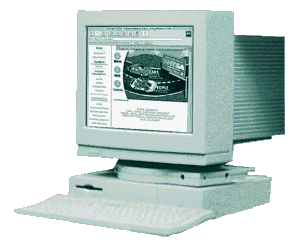
|
WHY SOME PEOPLE
ARE AT RISK
|
How do air bag deaths
occur?
Air bags are designed to save lives and prevent injuries by
cushioning occupants as they move forward in a front-end crash. By
providing a cushion, an air bag keeps the occupant's head, neck, and
chest from hitting the steering wheel or dashboard. To perform well,
an air bag must deploy quickly and forcefully. The force is greatest
in the first 2-3 inches after the air bag bursts through its cover
and begins to inflate. Those 2-3 inches are the "risk zone." The
force decreases as the air bag inflates farther.
Occupants who are very close to or on top of the air bag when it
begins to inflate can be hit with enough force to suffer serious
injury or death. However, occupants who are properly restrained and
sit 10 inches away from the air bag cover will contact the air bag
only after it has completely or almost completely inflated. The air
bag then will cushion and protect them from hitting the hard surfaces
in the vehicle.
Do both children and
adults face risk?
Yes, both children and adults face the risk of air bag injury or
death if they are positioned too close to the air bag or fail to use
proper restraints. As of November 1, 1997, NHTSA has confirmed that
49 young children have died, all on the passenger side. 38 adults
have died -- 35 drivers and 3 passengers.
|
What were the specific
circumstances of the children's deaths?
Almost all of the 49 children who died were improperly restrained
or positioned. 12 were infants under age 1 who were riding in
rear-facing infant seats in front of the passenger air bag. When
placed in the front seat, a rear-facing infant seat places an
infant's head within a very few inches of the passenger air bag. In
this position, an infant is almost certain to be injured if the air
bag deploys. Rear-facing infant seats must ALWAYS be placed in the
back seat.
The other 37 children ranged in age from 1 to 9 years; most were 7
or under. Twenty nine of them were totally unrestrained. This
includes 4 children who were sitting on the laps of other occupants.
The remaining 8 children included some who were riding with their
shoulder belts behind them and some who were wearing lap and shoulder
belts, but who also should have been in booster seats because of
their small size and weight. Booster seat use could have improved
shoulder belt fit and performance. These various factors allowed the
37 children to get too close to the air bag when it began to inflate.
What were the specific
circumstances of the adults' deaths?
Most of the adults who were killed by air bags were not properly
restrained. Eighteen of the 35 drivers, and 2 of the 3 passengers,
were totally unbelted. Two of the drivers who were belted had
medical conditions which caused them to slump over the steering wheel
immediately before the crash. A few of the drivers did not use their
seat belts correctly and the others are believed to have been sitting
too close to the steering wheel.
|
|
SEE FOR YOURSELF
Visit the NHTSA Web site at http://www.nhtsa.dot.gov
and click on the icon "AIR BAGS - Information about air bags." A video
shows crash tests of properly belted dummies whose air bags are turned off.
A properly belted short female dummy without an air bag is shown slamming
her head hard enough to bend the steering wheel and suffer fatal injuries.
For more information, call the NHTSA Hotline at 1-800-424-9393.
|
REDUCING THE RISK
|
What is the safest way to
ride in front of an air bag?
First, move the seat back and buckle up -- every time, every trip.
The lap belt needs to fit over your hips, not your abdomen, and the
shoulder belt should lie on your chest and over your shoulder.
Remove any slack from the belt. In a crash, seat belts stretch and
slow down your movement toward the steering wheel or dashboard.
Moving back and properly using seat belts give the air bag a chance
to inflate before you move forward in a crash far enough to contact
the air bag.
How do I best protect
children?
Never place a rear-facing infant seat in the front seat if the air
bag is turned on. Always secure a rear-facing seat in the back seat.
Children age 12 and under should ride in the back seat. While almost
all of the children killed by an air bag were 7 years old or younger,
a few older children have been killed. Accordingly, age 12 is
recommended to provide a margin of safety.
|
There are instances when children must sit in the front, because
the vehicle has no rear seat, there are too many children for all to
ride in back, or a child has a medical condition that requires
monitoring. If children must sit in the front seat, they should use
the seat belts and/or child restraint appropriate for their weight or
size (see the table at the end of this brochure) and sit against the
back of the vehicle seat. The vehicle seat should be moved as far
back from the air bag as practical. Make sure the child's shoulder
belt stays on. If adult seat belts do not fit properly, use a
booster seat. Also, children must never ride on the laps of
others.
What should teenagers and
adults do to be safest on the passenger side?
Always wear seat belts. This reduces the distance that they
can move forward during a crash. Move the seat toward the rear. The
distance between a passenger's chest and the dashboard where the air
bag is stored is usually more than 10 inches, even with the passenger
seat all the way forward. But more distance is safer.
|
B
U
C
K
L
I
N
G
U
P
A
N
D
G
E
T
T
I
N
G
I
N
T
O
T
H
E
C
O
R
R
E
C
T
P
O
S
I
T
I
O
N
|
|
How do I stay safe
when I'm driving?
Since the risk zone for driver air bags is the first 2-3
inches of inflation, placing yourself 10 inches from your driver
air bag provides you with a clear margin of safety. This
distance is measured from the center of the steering wheel to
your breastbone. If you now sit less than 10 inches away, you
can change your driving position in several ways:
- Move your seat to the rear as far as you can while still
reaching the pedals comfortably.
- Slightly recline the back of the seat. Although vehicle
designs vary, many drivers can achieve the 10-inch distance,
even with the driver seat all the way forward, simply by
reclining the back of the seat somewhat. If reclining the back
of your seat makes it hard to see the road, raise yourself by
using a firm, non-slippery cushion, or raise the seat if your
vehicle has that feature.
- If your steering wheel is adjustable, tilt it downward.
This points the air bag toward your chest instead of your head
and neck.
[In its published version, the brochure will be 10 inches tall
and will indicate that it should be placed between your
breastbone and the center of the air bag cover to check your
distance.]
|
|
Wrong
Unbelted and too close |
Use Seat Belts |
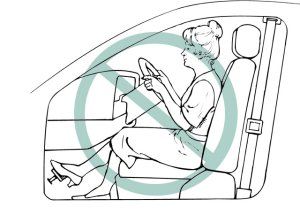 |
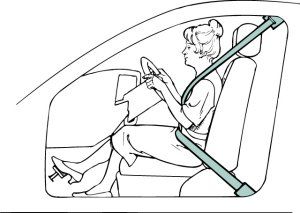 |
| Move Seat Rearward |
Recline Back of Seat |
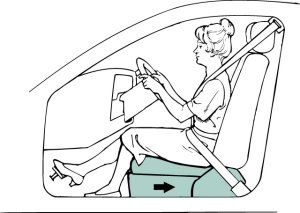 |
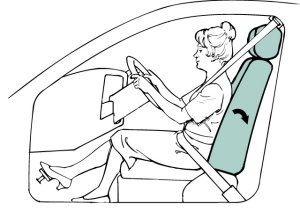 |
| Tilt Wheel Down |
Correct
Belted and 10 inches or more away |
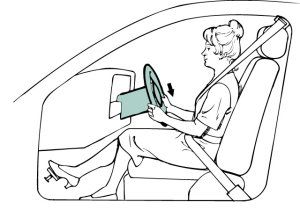 |
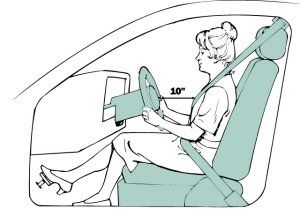 |
|
Will following these
safety tips guarantee that I will be safe in a
crash?
There is no guarantee of safety in a crash, with or without an
air bag. However, most of the people killed by air bags would not
have been seriously injured if they had followed these safety
tips.
|
|
|
|
Are air bags the reason the back
seat is the safest place for children?
No. The back seat has always been safer, even before there were air
bags. NHTSA conducted a study of children who died in crashes in the front
and back seats of vehicles, very few of which had passenger air bags. The
study concluded that placing children in the back reduces the risk of death
in a crash by 27 percent, whether or not a child is restrained.
|
THE ON-OFF
SWITCH DECISION
|
C A U T I O N : If
you allow children to ride in the front seat while unrestrained or
improperly restrained, and especially if you sit with a child on your lap,
you are putting them at serious risk, with or without an air
bag. Turning off the air bag is not the safe answer. It would
eliminate air bag risk but not the likelihood that in a crash an
unrestrained child would fly through the air and strike the dashboard or
windshield, or be crushed by your body.
|
Vehicle owners and lessees can obtain an on-off switch for one
or both of their air bags only if they can certify that they are, or a user
of their vehicle is, in one of the four risk groups listed below:
Two risk groups have a high enough risk that they would
definitely be better off with an on-off switch:
- Infants in rear-facing infant seats. A
rear-facing infant seat must never be placed in the front seat
unless the air bag is turned off.
- Drivers or passengers with unusual medical
conditions. These are people who have been advised by a
physician that an air bag poses a special risk to them because of their
condition. However, they should not turn off their air bag unless their
physician also has advised them that this risk is greater than what may
happen if they do turn off their air bag. Without an air bag, even
belted occupants could hit their head, neck or chest in a crash.
|
A national conference of physicians considered all medical conditions
commonly cited as possible justifications for turning off air bags. The
physicians did not recommend turning off air bags for persons with
pacemakers, supplemental oxygen, eyeglasses, median sternotomy, angina,
chronic obstructive pulmonary disease, emphysema, asthma, breast
reconstruction, mastectomy, scoliosis (if the person can be positioned
properly), previous back or neck surgery, previous facial reconstructive
surgery or facial injury, hyperacusis, tinnitus, advanced age, osteogenesis
imperfecta, osteoporosis & arthritis (if the person can sit at a safe
distance from the air bag), previous ophthalmologic surgery, Down syndrome
and atlantoaxial instability (if the person can reliably sit
properly aligned), or pregnancy. The physicians recommended turning off an
air bag if a safe sitting distance or position cannot be maintained by a
driver because of scoliosis or achondroplasiaor by a passenger because of
scoliosis or Down syndrome and atlantoaxial instability. The physicians
also noted that a passenger air bag might have to be turned off if an
infant or child has a medical condition and must ride in front so that he
or she can be monitored. To
obtain a copy of the recommendations, call the NHTSA Hotline or see the
NHTSA Web site.
|
|
Two other risk groups may
be better off with an air bag on-off switch:
- Children ages 1 to 12. Children in this age group
can be transported safely in the front seat if they are properly
belted, they do not lean forward, and their seat is moved all the
way back. The vast majority of all fatally injured children in this age
range were completely unrestrained. But children sometimes sit or
lean far forward and may slip out of their shoulder belts, putting
themselves at risk. The simple act of leaning far forward to change the
radio station can momentarily place even a belted child in danger. If a
vehicle owner must transport a child in the front seat, the owner is
eligible for an on-off switch for the passenger air bag. Since air bag
performance differs from vehicle model to vehicle model, the vehicle
owner may wish to consult the vehicle manufacturer for additional advice.
- Drivers who cannot get back 10 inches. Very few
drivers are unable to sit so that their breastbone is 10 inches away from
their air bag. If, despite your best efforts, you cannot maintain a
distance of 10 inches, you may wish to consult your dealer or
vehicle manufacturer for advice or modifications to help you move
back.
Since the risk zone is the first 2-3 inches from the air bag cover,
sitting back 10 inches provides a clear margin of safety. While getting
back at least 10 inches is desirable, if you can get back almost 10 inches,
the air bag is unlikely to seriously injure you in a crash and you probably
don't need an on-off switch. If you cannot get back almost 10 inches from
the air bag cover, you may wish to consider an on-off switch. Since air
bag performance differs among vehicle models, you may wish to consult your
vehicle manufacturer for additional advice.
What if you are, or a user of
your vehicle is, not in one of the listed risk groups?
You are not at risk and do not need an on-off switch. This includes
short people, tall people, older people, pregnant women -- in fact, all
people, male or female over age 12, who buckle their seat belts and who
can sit with 10 inches from the center of their breastbone to where the
air bag is stored. You will have the full benefit of your air bag and
will minimize the risk of violently striking the steering wheel and
dashboard in a moderate to severe crash.
|
How do I get an on-off switch?
If you are eligible, you must fill out a NHTSA request form. Forms
are available at state motor vehicle offices and may be available at
automobile dealers and repair shops. You may also get one by calling the
NHTSA Hotline or visiting the NHTSA Web site. On the form, you must
indicate which air bags you want equipped with an on-off switch, certify
that you have read this information brochure, certify that you are, or a
user of your vehicle is, a member of a risk group listed above, and
identify the group. Then send this form to NHTSA. Upon approval of your
request, the agency will send you a letter authorizing an automobile
dealer or repair shop to install an on-off switch in your vehicle.
|
Should a pregnant woman get an
on-off switch?
No, not unless she is a member of a risk group. Pregnant women should
follow the same advice as other adults: buckle up and stay back from the
air bag. The lap belt should be positioned low on the abdomen, below the
fetus, with the shoulder belt worn normally. Pull any slack out of the
belt. Just as for everyone else, the greatest danger to a pregnant woman
comes from slamming her head, neck or chest on the steering wheel in a
crash. When crashes occur, the fetus can be injured by striking the
lower rim of the steering wheel or from crash forces concentrated in the
area where a seat belt crosses the mother's abdomen. By helping to
restrain the upper chest, the seat belt will keep a pregnant woman as far
as possible from the steering wheel. The air bag will spread out the
crash forces that would otherwise be concentrated by the seat belt.
|
|
ON-OFF SWITCH
PRECAUTIONS
|
If I turn off my air bag
for someone at risk, what precautions should I take for
others?
Since the air bag will not automatically turn itself back on after
you turn it off with an on-off switch, you must remember to turn it
on when someone who is not at risk is sitting in that seat. Every
on-off switch has a light to remind you when the air bag is turned
off.
If I turn off my air bag,
will my seat belts provide enough protection?
Air bags increase the protection you can get from seat belts
alone. If the air bag is turned off, you lose this extra
protection.
|
In some newer vehicles, turning off your air bag may have
additional consequences. These vehicles have seat belts that were
specially designed to work together with air bags. If the crash
forces become too great, these new seat belts "give" or yield to
avoid concentrating too much force on your chest. The air bag
prevents you from moving too far forward after the seat belts give.
Without the air bag to cushion this forward movement, the chance of
the occupant hitting the vehicle interior is increased.
Ask your vehicle manufacturer whether your seat belts were
specially designed to work with an air bag. If they were, your
dealer or repair shop will provide you information about the effects
that turning off your air bag will have on the performance of the
belts. Ask your dealer or repair shop to show you this information
before you decide whether to have an on-off switch installed.
|
HOW AIR BAGS WORK
|
Air bags are designed to keep your head, neck, and chest from
slamming into the dash, steering wheel or windshield in a front-end
crash. They are not designed to inflate in rear-end or rollover
crashes or in most side crashes. Generally, air bags are designed to
deploy in crashes that are equivalent to a vehicle crashing into a
solid wall at 8-14 mph. Air bags most often deploy when a vehicle
collides with another vehicle or with a solid object like a tree.
Air bags inflate when a sensor detects a front-end crash. The
sensor sends an electric signal to start a chemical reaction that
inflates the air bag with harmless nitrogen gas. All this happens
faster than the blink of an eye. Air bags have vents, so they
deflate immediately after cushioning you. They cannot smother you
|
and they don't restrict your movement. The "smoke" you may have seen
in a vehicle after an air bag demonstration is the nontoxic starch or
talc that is used to lubricate the air bag.
Are all air bags the
same?
No. Air bags differ in design and performance. There are
differences in the crash speeds that trigger air bag deployment, the
speed and force of deployment, the size and shape of air bags, and
the manner in which they unfold and inflate. That is why you should
contact your vehicle manufacturer if you want specific information
about the air bags in your particular car or truck.
|
FUTURE AIR BAGS
|
Do I need an on-off switch
if I buy a vehicle with depowered air bags?
Many manufacturers are installing depowered air bags beginning
with their model year 1998 vehicles. They are called "depowered"
because they deploy with less force than current air bags. They will
reduce the risk of air bag-related injuries. However, even with
depowered air bags, rear-facing child seats still should never be
placed in the front seat and children are still safest in the back
seat. Contact your vehicle manufacturer for further information.
|
Will on-off switches be
necessary in the future?
Manufacturers are actively developing so-called "smart" or
"advanced" air bags that may be able to tailor deployment based on
crash severity, occupant size and position, or seat belt use. These
bags should eliminate the risks produced by current air bag designs.
It is likely that vehicle manufacturers will introduce some form of
advanced air bags over the next few years.
|
WHAT RESTRAINT IS RIGHT FOR YOUR CHILD?
|
| Weight or size of your child |
Proper type of restraint
(Put your child in back seat, if possible) |
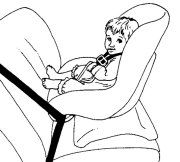 Children less than 20 pounds,* or less than 1 year |
Rear-facing infant seat
(secured to the vehicle by the seat belts) |
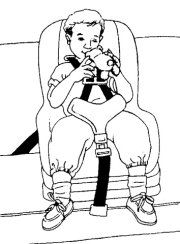 Children from about 20 to 40 pounds* and at least 1 year |
Forward-facing child seat
(secured to the vehicle by the seat belts) |
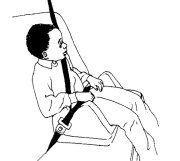 Children more than 40 pounds* |
Booster seat, plus both portions of a lap/shoulder belt
(except only the lap portion is used with some booster seats equipped with front shield) |
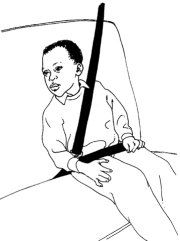 Children who meet both criteria below:
- Their sitting height is high enough so that they can, without the aid of a booster seat, wear the shoulder belt comfortably across their shoulder, and secure the lap belt across their pelvis, and
- Their legs are long enough to bend over the front of the seat when their backs are against the vehicle seat back
|
Both portions of a lap/shoulder belt |
| * To determine whether a particular restraint is appropriate for your child, see restraint manufacturer's recommendations concerning the weight of children who may safely use the restraint. |
|













